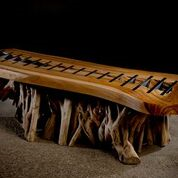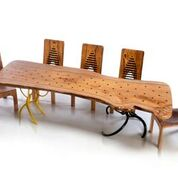The Work of Steve Tobin
By Leon Castner

Quakertown is a small Pennsylvania town in Bucks County, about half way between Allentown and Philadelphia. Although uniquely known for the John Fries’ Rebellion in 1799, it is not particularly of cultural or artistic renown, and has no major museum or antique center. The landscape is relatively pastoral, except for Rt. 309, which has the normal variety of store chains and strip malls clustered around the thoroughfare. Just a few streets parallel to the traffic movement is a group of Industrial Parks, quite unremarkable, except for the fact that the lots contain some of the most unusual and dramatic outdoor sculptures one has ever seen.
These are the work of the world recognized artist Steve Tobin, who happens to have his studios and foundry along California Road. These massive and spectacular creations appear like stationary dinosaurs, in various colors, interwoven in wavy lines and erupting from the ground like the tips of openwork metal icebergs.
These are only the most obvious products of Tobin’s efforts, however. His early work centered on glass and unusual blown glass experimentation. His first outdoor installation was called “Waterglass,” displayed in Wheaton Village, New Jersey. A few years later in 1985-1986 he worked as a teacher of glass sculpture at The Tokyo Glass Art Institute. His work is exhibited throughout Japan. His first US large scale glass sculptures were titled Cocoons and exhibited in Philadelphia in 1988. (Some of these have already been sold at the secondary auction level, establishing a track record for the art and the artist.)
 Next came a period where Tobin began experimenting with blown and cast glass and metal, creating “doors” of transparent yet solid reality, like living tombstones. In his “exploded earth” series he depicts uneven and jagged shapes that are alive with color and texture. They can be small (13”x20”) or monumental. His “torso” series feature bodies rising from the earth, like Daniel’s Old Testament vision of a creature having a gold head and clay and iron feet. A series called “Earth Bronzes” were exhibited at the Museum of Natural History in New York in 2000.
Next came a period where Tobin began experimenting with blown and cast glass and metal, creating “doors” of transparent yet solid reality, like living tombstones. In his “exploded earth” series he depicts uneven and jagged shapes that are alive with color and texture. They can be small (13”x20”) or monumental. His “torso” series feature bodies rising from the earth, like Daniel’s Old Testament vision of a creature having a gold head and clay and iron feet. A series called “Earth Bronzes” were exhibited at the Museum of Natural History in New York in 2000.

His work in monumental root-like forms showcase the Quakertown landscape. Perhaps his most famous work to date is “Trinity Root”-a sculpture created to commemorate the 9/11 attack in New York. This work was based on a huge 70-year old sycamore tree that was smashed when the World Trade Center collapsed. This tree reportedly bore the brunt of the falling debris and saved St. Paul’s and the churchyard. The tree had been uprooted and/or split by the impact and held the remnants of falling objects, including a large beam from the building.

Tobin eventually was able to have the stump and root structure excavated and used it as the basis for a bronze memorial titled “Trinity Root”-the first and only memorial in lower Manhattan for nearly ten years. The sculpture is now part of a lawsuit, since the church reportedly removed it from the courtyard without the artist’s permission in 2015 and taken to their property in Connecticut. (This has become a significant lawsuit since it cites the VARA (Visual Artists Rights Act) enacted by Congress in 1990 to give visual artists protection for their moral rights, attribution, and/or dignity. (Tobin had created and installed the sculpture using his own personal resources to “honor the victims of 9/11, the sacrifices of the first responders and the miracle of the tree that preserved St. Paul’s Chapel.”)
The suit contends that Tobin and the Church agreed to the installation and placement of the sculpture in permanency. Their removal, without permission and/or notice, plus subsequent damage in its removal is key to the argument.
Whatever the outcome, Tobin’s reputation remains intact and will probably be heightened. His work has been featured at Rago Arts & Auction Center in Lambertville, as well as having sold at Freeman’s in Philadelphia, and other auctions featuring contemporary and late 20th century art.
 My own personal experience with Steve’s work was with an insurance claim from Hurricane Sandy. Steve had created a glass tepee, made of thousands of elongated glass capillary tubes and steel, measuring 25’ x 12’x 12.’ This tepee, part of a series of works known as “Waterglass,’ had been made in 1992. It had been exhibited at Lehigh University and then placed on a small field near his home In Quakertown. The tepee was an amazing structure, reportedly used as a flight pattern beacon when the sun was out-brilliant as a diamond.
My own personal experience with Steve’s work was with an insurance claim from Hurricane Sandy. Steve had created a glass tepee, made of thousands of elongated glass capillary tubes and steel, measuring 25’ x 12’x 12.’ This tepee, part of a series of works known as “Waterglass,’ had been made in 1992. It had been exhibited at Lehigh University and then placed on a small field near his home In Quakertown. The tepee was an amazing structure, reportedly used as a flight pattern beacon when the sun was out-brilliant as a diamond.
His most recent endeavor is the development of a line of custom made furniture, a la George Nakashima. The unique tree-trunk forms, wonderfully figured tops, often embedded with pearls or metal resembling railroad tracks, are a juxtaposition of the natural and man-made, a metaphysical weld of physical and spiritual.
This new direction comes from Tobin’s attempts to find his own dining room table. Unsatisfied with what was available, he decided to ask Scott Milikan of Cider Press Woodworks Studio in Quakertown, to help form a table that was both whimsical and functional. The result was a cherry wood table embedded with pearls.
This created a new urge to design and create furniture that was both functional yet poetic and philosophical. He discovered the perfect raw material in Costa Rica and working with Kevin Yardley of Diamond Teak, he chose wood that was unusual, beautiful, and from a sustainable farm (green certified). These creations are undoubtedly both artistic and functional and their longevity will outlast my lifetime. However, this is a new endeavor, and Mr. Tobin is an uneasy jack of all trades. It is unclear whether this venture will be permanent or another chapter in an evolving presence.


When all is said and done, the name of Steve Tobin will be remembered, if not revered. He is a modern Renaissance artist. His works in glass, metal, wood, and other materials will last the test of time and become the antiques of the future-probably the not too distant future.
 Fallen Mango Tree Table and Chairs
Fallen Mango Tree Table and Chairs
Steve Tobin’s works can be seen on his website www.stevetobin.com. For appraising Tobin’s works, or similar furniture, sculpture, glass, or art, check us out at www.nacphilly.com for contact information and phone numbers.




No Comment
You can post first response comment.